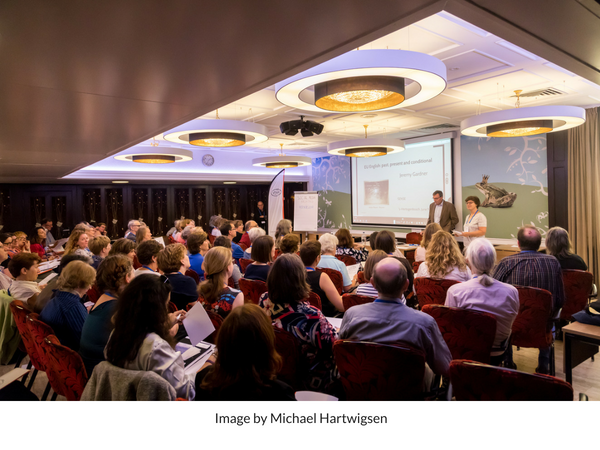
Slipshod
As a freelance translator, editor and writer, my work shoes are slippers. I’m slipshod in the original sense of the word – shod in slippers – while trying to produce work that isn’t. For the SENSE 2018 Conference in Den Bosch on 9 and 10 June, it was time to exchange my slippers for a pair of proper shoes, time to leave my familiar desk and venture out into the world.
This is exactly what Sarah Griffin-Mason, Chair of the Institute of Translation and Interpreting, urged us to do in her plenary talk at the end of the conference. The theme of the conference was ‘Englishes now! Trends affecting language professionals’, and Griffin-Mason talked about these trends. The main ones are artificial intelligence, machine translation and the gig economy. If we’re not careful, people will start to believe they no longer need human translators, editors, writers and interpreters, even though humans understand context in a way that machines cannot – not yet at least.
The trouble, Griffin-Mason continued, is that many of us become language professionals because we want to shut ourselves off from the world and think about words. We like wearing slippers. However, the time has come for the slipshod to leave the safety of our home offices and tell the world what we do. This brings us to another problem with language workers, said Griffin-Mason. We’re good at helping others communicate, but not so good at telling the world why it needs us. And it does need us, if Jeremy Gardner’s plenary talk that opened the conference is anything to go by.
Gibberish and gobbledygook
Gardner’s talk was a cautionary tale of what you get when good language goes bad: jargon, gibberish and gobbledygook. And claptrap, hocus-pocus, jabber, twaddle, balderdash, double Dutch, baloney and hogwash. The EU’s form of English, which was what Gardner’s talk was about, is a prime example. For insiders, it’s obvious that ‘ovine animals’ are sheep and ‘caprine animals’ are goats, and that every other word is an abbreviation of something else. Insiders also know that an ‘enterprise’ is a business, that a ‘mission’ is a business trip and that ‘agents’ are simply people who work for the EU. For outsiders, however, this is gibberish and gobbledygook. Could, Gardner wondered, the EU’s opaque communication be one of the reasons why the public is so hostile to it? If the EU was clearer in its communication, would the public be more aware of what it does? Could a beslippered editor have saved Britain from Brexit? Who knows?
Jargon was also a theme in another presentation I had signed up for: Charles Frink on how poor writing habits are inherited. The presentation was on academic writing this time, but again the message was how important clear communication is. Unfortunately, academic writing is becoming less readable and more jargon-filled, which makes it increasingly difficult for non-specialist readers to understand. Does that matter? Well yes, because non-specialist readers could be on the grant-assessment boards that decide whether to award a researcher a grant. What makes for good academic writing? It’s the same as with any writing. The text needs to be readable. It needs to tell a story. It should avoid jargon, the passive and complex sentences. It should express rather than impress.
Good and bad academic writing
Whereas Charles Frink spoke about what makes academic writing good, Valerie Matarese talked about what makes academic writing bad. She explained how researchers use source texts or a corpus of texts – textual mentors – to inform their writing. If these textual mentors are badly written, this style is propagated. She called them ‘bad textual mentors’. Again, good language gone bad. It is our job, as editors, to correct bad textual mentors.
Maria Sherwood-Smith also focused on the importance of clear communication in academic writing. With Dutch universities expecting researchers to communicate their research to non-specialists, this may mean opportunities for language professionals. This could be in the form of editing, translating or teaching.
Stout pair of boots
The conclusion from all of this is that while we know why the world needs language professionals, the world does not. The world might think that rough and ready machine translations are fine. The world might think that as long as you get your message across it doesn’t matter how you say it. What the world doesn’t realize is that how you say it often means that you don't get your message across.
We, the slipshod, must therefore leave the comfort of our home offices – perhaps only virtually – and tell the world why it needs us. Or, as they say in Dutch, we moeten onze stoute schoenen aantrekken.* We must don a stout pair of boots and be stout-hearted enough to get our message across before the machines take over.
* 'We have to don a stout pair of shoes.' The Dutch stout and the English stout are related but have parted ways over the years. The Dutch stout now means naughty or impertinent but can also mean daring, audacious or brave, which is the sense of stoute schoenen aantrekken. This is why Karel de Stoute is Charles the Bold in English rather than Charles the Naughty. The English stout also meant proud, fierce, strong and defiant in the past. It also meant having a powerful build, which is where the stout shoes come from, and has since come to mean thickset or corpulent.
 Marianne Orchard is SENSE's content manager. She is a freelance translator (Dutch to English), editor and writer who specializes in creative texts.
Marianne Orchard is SENSE's content manager. She is a freelance translator (Dutch to English), editor and writer who specializes in creative texts.

